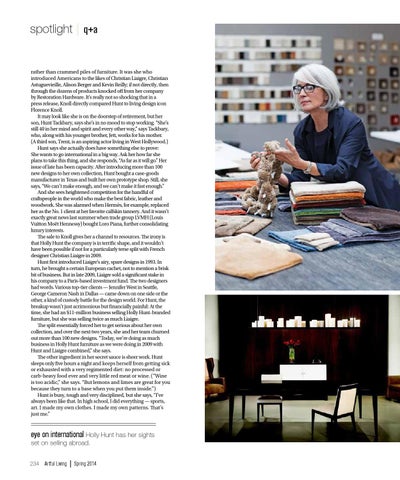spotlight || q+a
rather than crammed piles of furniture. It was she who introduced Americans to the likes of Christian Liaigre, Christian Astuguevieille, Alison Berger and Kevin Reilly; if not directly, then through the dozens of products knocked off from her company by Restoration Hardware. It’s really not so shocking that in a press release, Knoll directly compared Hunt to living design icon Florence Knoll. It may look like she is on the doorstep of retirement, but her son, Hunt Tackbary, says she’s in no mood to stop working. “She’s still 40 in her mind and spirit and every other way,” says Tackbary, who, along with his younger brother, Jett, works for his mother. (A third son, Trent, is an aspiring actor living in West Hollywood.) Hunt says she actually does have something else to prove: She wants to go international in a big way. Ask her how far she plans to take this thing, and she responds, “As far as it will go.” Her issue of late has been capacity. After introducing more than 100 new designs to her own collection, Hunt bought a case-goods manufacturer in Texas and built her own prototype shop. Still, she says, “We can’t make enough, and we can’t make it fast enough.” And she sees heightened competition for the handful of craftspeople in the world who make the best fabric, leather and woodwork. She was alarmed when Hermès, for example, replaced her as the No. 1 client at her favorite calfskin tannery. And it wasn’t exactly great news last summer when trade group LVMH (Louis Vuitton Moët Hennessy) bought Loro Piana, further consolidating luxury interests. The sale to Knoll gives her a channel to resources. The irony is that Holly Hunt the company is in terrific shape, and it wouldn’t have been possible if not for a particularly terse split with French designer Christian Liaigre in 2009. Hunt first introduced Liaigre’s airy, spare designs in 1993. In turn, he brought a certain European cachet, not to mention a brisk bit of business. But in late 2009, Liaigre sold a significant stake in his company to a Paris-based investment fund. The two designers had words. Various top-tier clients — Jennifer West in Seattle, George Cameron Nash in Dallas — came down on one side or the other, a kind of custody battle for the design world. For Hunt, the breakup wasn’t just acrimonious but financially painful: At the time, she had an $11-million business selling Holly Hunt–branded furniture, but she was selling twice as much Liaigre. The split essentially forced her to get serious about her own collection, and over the next two years, she and her team churned out more than 100 new designs. “Today, we’re doing as much business in Holly Hunt furniture as we were doing in 2009 with Hunt and Liaigre combined,” she says. The other ingredient in her secret sauce is sheer work. Hunt sleeps only five hours a night and keeps herself from getting sick or exhausted with a very regimented diet: no processed or carb-heavy food ever and very little red meat or wine. (“Wine is too acidic,” she says. “But lemons and limes are great for you because they turn to a base when you put them inside.”) Hunt is busy, tough and very disciplined, but she says, “I’ve always been like that. In high school, I did everything — sports, art. I made my own clothes. I made my own patterns. That’s just me.”
eye on international Holly Hunt has her sights set on selling abroad.
234 Artful Living
| Spring 2014
